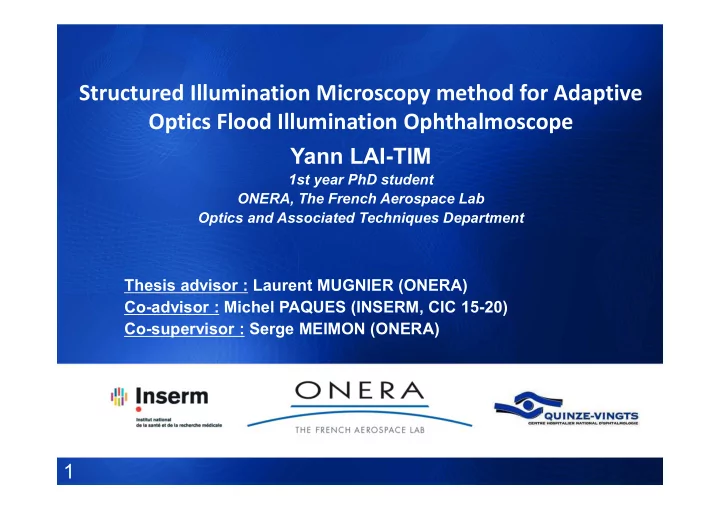

Structured Illumination Microscopy method for Adaptive Optics Flood Illumination Ophthalmoscope Yann LAI-TIM 1st year PhD student ONERA, The French Aerospace Lab Optics and Associated Techniques Department Thesis advisor : Laurent MUGNIER (ONERA) Co-advisor : Michel PAQUES (INSERM, CIC 15-20) Co-supervisor : Serge MEIMON (ONERA) 1 GEN-F178-2 (GEN-SCI-029)
Outline 1. Context of Retinal imaging 2. Presentation of the experimental set-up 3. Structured Illumination Microscopy (SIM) for retinal imaging 4. Simulation results 5. Conclusion and perspectives 2 GEN-F178-2 (GEN-SCI-029)
1. Retinal imaging : Context Glaucoma AMD Diabetic retinopathy → High resolution in vivo retina images at the cellular-scale for early diagnosis Specificities of retinal imaging : • Pupil of the eye limits the numerical aperture • Eye motion • Dynamic and static optical aberrations • Low incident illumination flux (Ocular safety standards) 3 GEN-F178-2 (GEN-SCI-029)
2. Adaptive Optics Flood-Illumination Ophthalmoscope (AO-FIO) 2 subsystems : • Wavefront (WF) Sensing & Control : Measures the WF aberrations and compensates them. • Illumination & Detection : Forms the retina image on a camera. Large Field of View (2.7°x5.4°) High framerate (200 Hz) High lateral resolution (2 µm) Enhanced contrast by image processing Gofas-Salas et al., 2018 Poor axial resolution and optical sectioning 4 GEN-F178-2 (GEN-SCI-029)
2. AO-FIO + Structured Illumination (SI) Conventional Image Structured Illumination Purpose : Improve the optical sectioning and the lateral resolution using an adapted Structured Illumination Microscopy (SIM) method for retinal imaging Digital Micromirror Device 50 µm 50 µm (DMD) Fringes are visible ! 5 GEN-F178-2 (GEN-SCI-029)
3. SIM for retinal imaging : Principles of SIM Object illuminated by a sinusoidal light pattern : Illumination pattern : SIM image ��� : Unknown object Super Resolution Aliasing 𝑙 � ��� � � −𝑙 � 𝑙 � 𝒅 −𝑙 � Gustaffson (2000) 3 orientations of the Moiré effect Optical spatial frequency cutoff � pattern : Isotropic Replica of the object spectrum increasing of the accessible spatial frequency domain 6 GEN-F178-2 (GEN-SCI-029)
3. SIM for retinal imaging : Image model Optical sectioning Effect of defocus on the spectrum of a 2D object and the Optical Transfer Function (OTF) : In-focus Defocus : OTF : Image Spectrum � � Modulation spatial frequency ��� � , Grupetta, 2013 Image model : ��� �� �� Conventional image « optically sectioned » (OS) In and out-of-focus In-focus content content 7 GEN-F178-2 (GEN-SCI-029)
3. SIM for retinal imaging : Proposed method (1/2) High resolution reconstruction of the object in-focus layer 𝟏 from the SIM data • Set of acquired images � � with structured illumination • Computation of the OS information : �|�� � ��� : image acquired with the object being homogenously illuminated �� MAP estimation of the eye motion shift � ��� ��� Computation of �|�� � � �� 8 SIM Images � � Images In-focus object Image with random shifts � GEN-F178-2 (GEN-SCI-029)
3. SIM for retinal imaging : Proposed method (2/2) • Inverse problem : ��� � � � � � � �|�� � : object in-focus layer to reconstruct � : PSF at the in-focus layer of the object � � : Gaussian noise of non-stationary variance � : Cosine part of the illumination pattern � � • Regularized cost function : � � ��� � � � � � � � � �|�� �� � � � � � � �� � ���� � � where , � � ��� � � ��� � : Power Spectral Density of the object o estimated from �� • Numerical minimization Finally : Reconstruction of the object in-focus layer 𝟏 9 GEN-F178-2 (GEN-SCI-029)
4. Simulation : SIM reconstruction of a simulated 2-layer object Green circle : optical resolution limit, Yellow circle : SIM resolution limit Image Reconstructed layer In-focus layer • SNR : 31.6 • 7 images x 3 orientations = 21 SIM images • →Improvement of lateral resolution + Optical sectioning 10 GEN-F178-2 (GEN-SCI-029)
Conclusion and perspectives Conclusion : Adapted SIM method for retinal imaging keeping the simplicity of a 2D image model Specificities : Illumination pattern parameters must be precisely known → Joint estimation of the illumination patterns ? Perspectives : Elaborate a more accurate retinal image formation model from the experimental data Study the influence of the instrumental parameters on the reconstruction quality SIM reconstructions on experimental data 11 GEN-F178-2 (GEN-SCI-029)
References Thank you for your attention [1] Gustaffson M.G.L. « Surpassing the lateral resolution limit by a factor of two using structured illumination microscopy ». Journal of Microscopy , 198:82-87, May 2000. [2] Grupetta S. « Structured illumination for in-vivo retinal imaging ». Frontiers in Optics 2013. [3] R. Baena-Gallé, L. Mugnier, F. Orieux. « Optical sectioning with Structured Illumination Microscopy for retinal imaging : inverse problem approach ». GRETSI 2017. [4] E. Gofas-Salas, P. Mecê et al., “High loop-rate Adaptive-Optics Flood Illumination Ophthalmoscope with structured illumination capability”, Appl. Opt. (submitted). 12 GEN-F178-2 (GEN-SCI-029)
3. Results: SIM reconstruction of a simulated 2-layer object (3/3) Spectrum of the reconstructed object : f c +f mod f c +f mod f c +f mod f c SNR = 31.6, 3 orientations, 7 images/orientation 13 GEN-F178-2 (GEN-SCI-029)
Adaptive optics for retinal imaging instrument Wavefront sensor 14 GEN-F178-2 (GEN-SCI-029)
Recommend
More recommend